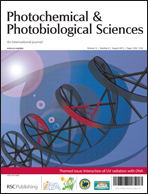A combined method of femtosecond broadband time-resolved fluorescence (fs-TRF) and transient absorption (fs-TA) was employed to investigate the excited state dynamics of 2′-deoxyguanosine (dG) and 2′-deoxyguanosine 5′-monophosphate (dGMP). Comparative fs-TRF and fs-TA measurements were conducted on dG and dGMP in neutral water, deuterated water, and methanol with excitation wavelengths of 245, 267 and 285 nm. Very similar results were observed with dG and dGMP. The data provide compelling evidence for the co-existence of two nonradiative pathways. One is the generally recognized Laππ* mediated channel, the other involves an unprecedented weakly emissive state which plays a significant role in the overall deactivation processes. The Laππ* channel features biphasic dynamics with time constants (τ1/τ2) of ∼0.2/0.8 ps in water and ∼0.25/1.0 ps in methanol. The biphasic decay arises due to a partial transfer with τ1 of the Laππ* population to the newly identified state followed by conversion in τ2 of the remaining Laππ* molecules into the electronic ground state. The channel mediated by the weakly emissive species shows solvent-dependent dynamics with time constants (τ3) of ∼2.0 ps in water, ∼2.3 ps in deuterated water, and ∼4.1 ps in methanol. The species features absorption at UV wavelengths (∼300–400 nm) and exhibits deeply red-shifted fluorescence (λmax ∼ 520 nm) with polarization direction varied markedly from that of the Laππ* but close to the Lbππ*. This species acts as an effective quenching state to the radiative decay of the brightly emissive Laππ* and Lbππ*. It sets in promptly (<∼50 fs) after the photoexcitation and is further populated through nonadiabatic coupling with the Laππ*. The overall involvement of this state is facilitated with excitation at high energy and is favoured in methanol over water. According to the spectral character and the solvent effect in particular the kinetic isotope effect, the species is tentatively associated to the πσ* state with charge transfer (CT) character which is considered to be preferentially stabilized by hydrogen-bonding between the guanine amino and surrounding solvent molecules. The result of this study leads to a dramatically different picture of guanine deactivation. It demonstrates a crucial role of the solvent in shaping the nonradiative dynamics of guanine nucleosides and nucleotides. The data presented are important for understanding the detailed photophysics of not only the monomeric guanine but also DNA assemblies that contain guanine in base pairs or have a guanine tetrad as the structural motif.

You have access to this article
 Please wait while we load your content...
Something went wrong. Try again?
Please wait while we load your content...
Something went wrong. Try again?


 Please wait while we load your content...
Please wait while we load your content...